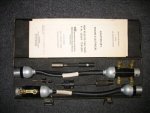When I time my engine, I run jumper cables from my first battery out the window and to the engine bay. At the live ends I lay a piece of plywood under to keep them from shorting to the sheet metal with a spring clamp on the insulated part of each lead of the cable clamping it to the board. Clamping each lead keeps them separate from each other. I hook the timing light to them and any other 12V gauges I have out there that day.
For an adapter, somebody told me that they took a piece of civilian spark plug wire, put a tack in each end for contacts and put it in between the stock spark plug wire and the plug. Then they put their inductive pickup on the "adapter" wire. I've never tried it but I suppose it would work but I don't know how he got the plug wires to stay connected to each other for the test (tape?). This is one areas where I think the right tool would be the best for the job. I've seen the timing adapters sold separate from the complete kits but if you plan on doing any maintenance/troubleshooting with the OE wiring, you might as well get a complete kit now.
I've loosened both bolts at the base to adjust my timing. I know the one that bolts the plate to the engine block is the preferred adjusting point but I had a distributor on once that I couldn't get the range for timing with it alone. I've replaced my distributor since but I still use both to adjust, whichever I feel like fiddling with that day.



